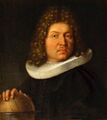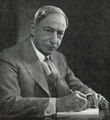Template:Selected anniversaries/August 16: Difference between revisions
No edit summary |
No edit summary |
||
| (4 intermediate revisions by the same user not shown) | |||
| Line 14: | Line 14: | ||
||1832: Wilhelm Maximilian Wundt born ... physician, physiologist, philosopher, and professor, known today as one of the founding figures of modern psychology. Wundt, who noted psychology as a science apart from philosophy and biology, was the first person ever to call himself a psychologist. He is widely regarded as the "father of experimental psychology." Pic. | ||1832: Wilhelm Maximilian Wundt born ... physician, physiologist, philosopher, and professor, known today as one of the founding figures of modern psychology. Wundt, who noted psychology as a science apart from philosophy and biology, was the first person ever to call himself a psychologist. He is widely regarded as the "father of experimental psychology." Pic. | ||
||1836: Marc-Antoine Parseval dies ... mathematician and theorist. | ||1836: Marc-Antoine Parseval dies ... mathematician and theorist. No pics online. | ||
||1842: Jakob Rosanes born ... mathematician, chess player, and academic. | ||1842: Jakob Rosanes born ... mathematician, chess player, and academic. Rosanes made significant contributions in Cremona transformations. Pic. | ||
||1845: Gabriel Lippmann born ... physicist and academic, Nobel Prize laureate. Pic. | ||1845: Gabriel Lippmann born ... physicist and academic, Nobel Prize laureate. Pic. | ||
| Line 26: | Line 26: | ||
||1858: U.S. President James Buchanan inaugurates the new transatlantic telegraph cable by exchanging greetings with Queen Victoria of the United Kingdom. However, a weak signal forces a shutdown of the service in a few weeks ... 1858, Queen Victoria sent the first official telegraph message across the Atlantic Ocean from London to the US. (Test messages had been exchanged for 10 days). Her message to President Buchanan, in Washington DC, began transmission at 10:50am and was completed at 4:30am the next day, taking nearly 18-hrs to reach Newfoundland. With 99 words, consisting of 509 letters, it averaged about 2-min per letter. The message was forwarded across Newfoundland by an overhead wire supported on poles; across Cabot Strait by submarine cable to Aspy Bay (Dingwall), Cape Breton; and by an overhead wire across eastern Canada and Maine, via Boston to New York. This earliest Transatlantic cable went dead within a month. | ||1858: U.S. President James Buchanan inaugurates the new transatlantic telegraph cable by exchanging greetings with Queen Victoria of the United Kingdom. However, a weak signal forces a shutdown of the service in a few weeks ... 1858, Queen Victoria sent the first official telegraph message across the Atlantic Ocean from London to the US. (Test messages had been exchanged for 10 days). Her message to President Buchanan, in Washington DC, began transmission at 10:50am and was completed at 4:30am the next day, taking nearly 18-hrs to reach Newfoundland. With 99 words, consisting of 509 letters, it averaged about 2-min per letter. The message was forwarded across Newfoundland by an overhead wire supported on poles; across Cabot Strait by submarine cable to Aspy Bay (Dingwall), Cape Breton; and by an overhead wire across eastern Canada and Maine, via Boston to New York. This earliest Transatlantic cable went dead within a month. | ||
||1863: Frederic Stanley Kipping born ... chemist. He undertook much of the pioneering work on silicon polymers and coined the term silicone. Pic | ||1863: Frederic Stanley Kipping born ... chemist. He undertook much of the pioneering work on silicon polymers and coined the term silicone. Pic search. | ||
||1867: Ronald Montagu Burrows born ... English archaeologist who in 1895-96 conducted excavations in southwestern Greece at Pylos and the adjacent island of Sphacteria, revealing remains of Spartan fortifications. These confirmed the battle of 425 BC in the Peloponnesian War recorded by the ancient Athenian historian Thucydides. Burrows was by nature a classicist, whose primary purpose in seeking tangible evidence from the past was to verify ancient texts. At Rhitsona, in Boeotia (1905, 1907), his original goal was to find the temple of Delium, but without success. Instead he found and catalogued artifacts from Boeotian graves dating from the 7th and 6th century B.C. at the necropolis of Mykalessos, near Tanagra. In 1907, he published Recent Discoveries in Crete. | ||1867: Ronald Montagu Burrows born ... English archaeologist who in 1895-96 conducted excavations in southwestern Greece at Pylos and the adjacent island of Sphacteria, revealing remains of Spartan fortifications. These confirmed the battle of 425 BC in the Peloponnesian War recorded by the ancient Athenian historian Thucydides. Burrows was by nature a classicist, whose primary purpose in seeking tangible evidence from the past was to verify ancient texts. At Rhitsona, in Boeotia (1905, 1907), his original goal was to find the temple of Delium, but without success. Instead he found and catalogued artifacts from Boeotian graves dating from the 7th and 6th century B.C. at the necropolis of Mykalessos, near Tanagra. In 1907, he published Recent Discoveries in Crete. | ||
||1874: Gerhard Hessenberg ... mathematician. He received his Ph.D. from the University of Berlin in 1899 under the guidance of Hermann Schwarz and Lazarus Fuchs. His name is usually associated with projective geometry, where he is known for proving that Desargues' theorem is a consequence of Pappus's hexagon theorem, and differential geometry where he is known for introducing the concept of a connection. | ||1874: Gerhard Hessenberg ... mathematician. He received his Ph.D. from the University of Berlin in 1899 under the guidance of Hermann Schwarz and Lazarus Fuchs. His name is usually associated with projective geometry, where he is known for proving that Desargues' theorem is a consequence of Pappus's hexagon theorem, and differential geometry where he is known for introducing the concept of a connection. Pic search. | ||
File:Orcagna scrying engine.jpg|link=Orcagna scrying engine|1883: The [[Orcagna scrying engine]] predicts that "the Father of Science Fiction will be born within a year." | File:Orcagna scrying engine.jpg|link=Orcagna scrying engine|1883: The [[Orcagna scrying engine]] predicts that "the Father of Science Fiction will be born within a year." | ||
| Line 42: | Line 42: | ||
||1892: Otto Messmer born ... cartoonist and animator, co-created Felix the Cat. | ||1892: Otto Messmer born ... cartoonist and animator, co-created Felix the Cat. | ||
||1893: Jean-Martin Charcot dies ... | ||1893: Jean-Martin Charcot dies ... ... neurologist and professor of anatomical pathology. He is best known today for his work on hypnosis and hysteria ... "the founder of modern neurology". Pic. | ||
||1893: Boris Hessen ... physicist, philosopher and historian of science. He is most famous for his paper on Newton's Principia which became foundational in historiography of science. Pic. | ||1893: Boris Hessen ... physicist, philosopher and historian of science. He is most famous for his paper on Newton's Principia which became foundational in historiography of science. Pic. | ||
||1894: Soldier and industrialist Gabriel de Solages dies. After serving in Italy, Germany and Bohemia he began exploiting coal mines on the family property near Carmaux in the Tarn department of southern France. To make use of surplus coal he opened a glass bottle factory and an iron works, and also opened a factory to make shipbuilding supplies. Pic. | |||
File:Robert Bunsen.jpg|link=Robert Bunsen (nonfiction)|1899: Chemist and academic [[Robert Bunsen (nonfiction)|Robert Bunsen]] dies. He investigated emission spectra of heated elements, and discovered caesium (in 1860) and rubidium (in 1861) with the physicist Gustav Kirchhoff. | File:Robert Bunsen.jpg|link=Robert Bunsen (nonfiction)|1899: Chemist and academic [[Robert Bunsen (nonfiction)|Robert Bunsen]] dies. He investigated emission spectra of heated elements, and discovered caesium (in 1860) and rubidium (in 1861) with the physicist Gustav Kirchhoff. | ||
| Line 76: | Line 76: | ||
||1966: Vietnam War: The House Un-American Activities Committee begins investigations of Americans who have aided the Viet Cong. The committee intends to introduce legislation making these activities illegal. Anti-war demonstrators disrupt the meeting and 50 people are arrested. | ||1966: Vietnam War: The House Un-American Activities Committee begins investigations of Americans who have aided the Viet Cong. The committee intends to introduce legislation making these activities illegal. Anti-war demonstrators disrupt the meeting and 50 people are arrested. | ||
||1973: Selman Waksman dies ... biochemist and microbiologist, Nobel Prize laureate. | ||1973: Selman Waksman dies ... biochemist and microbiologist, Nobel Prize laureate. Pic (lab!). | ||
||1989: A solar flare from the Sun creates a geomagnetic storm that affects micro chips, leading to a halt of all trading on Toronto's stock market. | ||1989: A solar flare from the Sun creates a geomagnetic storm that affects micro chips, leading to a halt of all trading on Toronto's stock market. | ||
| Line 90: | Line 90: | ||
|File:Ultravore.jpg|link=Ultravore|2017: Researchers publish new evidence that "suicide-by-[[Ultravore]]" is on the rise. | |File:Ultravore.jpg|link=Ultravore|2017: Researchers publish new evidence that "suicide-by-[[Ultravore]]" is on the rise. | ||
||2015: Jacob Bekenstein dies ... theoretical physicist, astronomer, and academic ... made fundamental contributions to the foundation of black hole thermodynamics and to other aspects of the connections between information and gravitation. | ||2015: Jacob Bekenstein dies ... theoretical physicist, astronomer, and academic ... made fundamental contributions to the foundation of black hole thermodynamics and to other aspects of the connections between information and gravitation. Pic. | ||
File:GW170817_spectrograms.png|link=GW170817 (nonfiction)|2017: The upcoming observation of the [[GW170817 (nonfiction)|GW170817]] gravitational wave signal, a significant breakthrough for multi-messenger astronomy, is allegedly hijacked before it can occur by a [[Crimes against astronomical constants|criminal transdimensional corporation]]. An emergency response team of police astronomers and high-energy physicists will locate the corporation and reverse the hijacking, causing the wave and its observation to occur on time. | File:GW170817_spectrograms.png|link=GW170817 (nonfiction)|2017: The upcoming observation of the [[GW170817 (nonfiction)|GW170817]] gravitational wave signal, a significant breakthrough for multi-messenger astronomy, is allegedly hijacked before it can occur by a [[Crimes against astronomical constants|criminal transdimensional corporation]]. An emergency response team of police astronomers and high-energy physicists will locate the corporation and reverse the hijacking, causing the wave and its observation to occur on time. | ||
</gallery> | </gallery> | ||
Latest revision as of 12:08, 7 February 2022
1650: Monk, cosmographer, and cartographer Vincenzo Coronelli born. He will gain fame for his atlases and globes; some of the globes will be very large and highly detailed.
1705: Mathematician Jacob Bernoulli dies. He discovered the fundamental mathematical constant e, and made important contributions to the field of probability.
1821: Mathematician and academic Arthur Cayley born. He will be the first to define the concept of a group in the modern way, as a set with a binary operation satisfying certain laws.
1883: The Orcagna scrying engine predicts that "the Father of Science Fiction will be born within a year."
1884: Inventor, writer, editor, and publisher Hugo Gernsback born. He will publish the first science fiction magazine, and have a profound influence on the development of science fiction.
1899: Chemist and academic Robert Bunsen dies. He investigated emission spectra of heated elements, and discovered caesium (in 1860) and rubidium (in 1861) with the physicist Gustav Kirchhoff.
2010: Mathematician, academic, and rabbi Eliezer 'Leon' Ehrenpreis dies. He proved the Malgrange–Ehrenpreis theorem, the fundamental theorem about differential operators with constant coefficients.
2017: The upcoming observation of the GW170817 gravitational wave signal, a significant breakthrough for multi-messenger astronomy, is allegedly hijacked before it can occur by a criminal transdimensional corporation. An emergency response team of police astronomers and high-energy physicists will locate the corporation and reverse the hijacking, causing the wave and its observation to occur on time.







